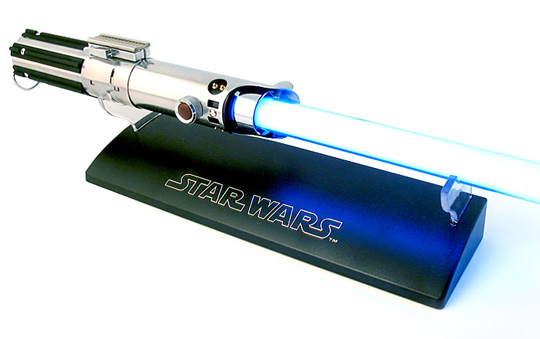This article is more than 1 year old
PAH! Four decades of Star Wars: No lightsabers, no palm-sized video calls
Sort of. Leia's a New Hope
Invisible pictures
With the message recorded and Princess captured, it now falls to plucky R2D2 to get the message to Ben Kenobi. But to do that, the droid will need to display the hologram. In the film, R2 simply projects a beam into space – very nice visually, still nearly impossible to do in reality.
During the last quarter-century we’ve seen:
- Cardboard propellers rotating at 30Hz, with a synchronised volumetric projection (reminiscent of a zoetrope).
- Projections into a nearly-invisible fog of water droplets (indistinct and, obviously, wet).
- Old-fashioned stereogram displays (special viewing eyewear required).
None of these provides anything like the experience seen in the film.
In January, researchers at the Australian National University announced they’d perfected a technology for projecting holograms into space – and the media breathlessly announced that Star Wars-style holograms lay right around the corner. But – as often is the case with these sorts of breakthroughs – the science tells a different (and more interesting) story.
Sergey Kruk – one of the principal investigators and co-author of the paper – says they’ve developed a way to create holograms (coherent-light holograms, not faux videogrammetry “holograms”) using silicon technology – the same tech used in chips. That in itself is quite a neat feat, because we have extensive knowledge about how to fabricate silicon. A silicon hologram would be easy and cheap to mass produce.
So far, so good. But this hologram drawn into silicon is static – a moment in time, while the princess needs a timeline. Moreover, the technology has been tuned to work in the infrared, invisible to our eyes. So there may be a hologram there, but we can’t see it. Kruk notes: “The technology has been optimised to work in the part of light spectrum that we use for telecommunications over optical fibres.”
Why make it work over optical fibres? Here’s the real scientific breakthrough: these silicon holograms pave the way towards an increase of data communication speeds – by a factor of hundreds. That’s a huge win – and a necessary technology for our information-obsessed society.

OK, you can technically own a lightsaber... but it won't be a lightsaber. If that sort of thing interests you, you can check out El Reg's 2011 feature on fictional blades – "Ten... fantasy swords you wish you owned" – here...
Great for datacomms, but no help at all to R2D2. Perhaps the droid generates a cloud of fog and projects into it? Or maybe it hands some nifty 3D spex to Obi-Wan? Sadly, this last bit of Star Wars’s magic still ain’t here. Linc Gasking, founder of videogrammetry startup 8i, acknowledges this gap. “We're all waiting for R2D2 – the display technology to project the hologram back once you've recorded it,” he said.
Maybe that’s as it should be: We need to have some future to look forward to, with juicy, hard problems. It’s an old dream, and something we can continue to aspire toward. More than twenty years before Lucas, the original SciFi classic – Forbidden Planet – also featured a pint-sized “hologram” of the film’s female lead, generated via the mental projection of an amplified human mind. We seem to treasure these delicate forms; contrast their gentle presences to the full-size hologram of Galen Erso – towering over daughter Jyn – in a key scene from Rogue One.
For these 40 years, Star Wars has inspired geeks everywhere to make the dream real. Tony Parisi, VR/AR strategy head at VR tools maker Unity, sums up the aspirations of two generations. “What I really want is Princess Leia rendered on the table in front of me. I mean – isn’t that where this is all going anyway?” ®
